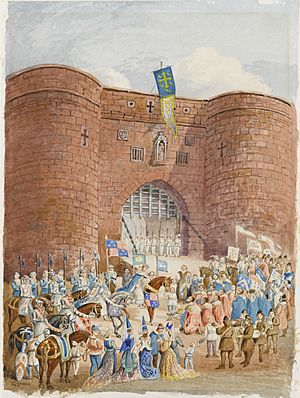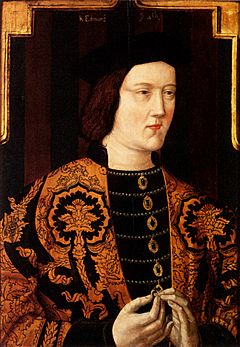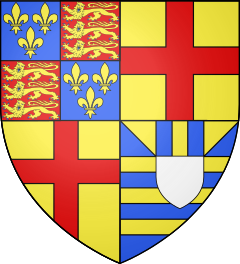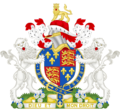Edward IV of England facts for kids
Quick facts for kids Edward IV |
|
|---|---|
 |
|
| King of England (more...) | |
| Reigns |
|
| Coronation | 28 June 1461 |
| Predecessor | Henry VI |
| Successor | Edward V |
| Born | 28 April 1442 Rouen, Normandy, France |
| Died | 9 April 1483 (aged 40) Westminster, Middlesex, England |
| Burial | 18 April 1483 St George's Chapel, Windsor Castle |
| Spouse | |
| Issue Among others |
|
| House | York (Plantagenet) |
| Father | Richard Plantagenet, 3rd Duke of York |
| Mother | Cecily Neville |
| Signature |  |
Edward IV (born 28 April 1442 – died 9 April 1483) was a King of England. He ruled from 1461 to 1470, and then again from 1471 until his death in 1483. Edward was a very important person during the Wars of the Roses. These were civil wars in England between two powerful families: the Yorkists and the Lancastrians. The wars lasted from 1455 to 1487.
Edward became the leader of the Yorkist family after his father, Richard, Duke of York, died in battle in 1460. Edward won important battles in 1461, like Mortimer's Cross and Towton. He then removed King Henry VI from the throne and became king himself.
In 1464, Edward secretly married Elizabeth Woodville. This caused problems with his main advisor, Richard Neville, Earl of Warwick, who was known as the "Kingmaker". In 1470, Warwick and Edward's brother, George, Duke of Clarence, led a rebellion. They briefly put Henry VI back on the throne.
Edward had to leave England and went to Flanders. He gathered support there and returned to England in 1471. He won two more battles, Barnet and Tewkesbury, and became king again. Soon after, Henry VI died in the Tower of London. Edward then ruled peacefully for the next twelve years. He died suddenly in 1483. His young son, Edward V, was supposed to become king, but Edward IV's brother, Richard III, soon took the throne instead.
Contents
Edward's Early Life and Family
Edward was born on 28 April 1442 in Rouen, France. He was the oldest surviving son of Richard, 3rd Duke of York, and Cecily Neville. Before his father died, Edward was known as the Earl of March. Both of Edward's parents were direct descendants of King Edward III. This gave Edward a strong claim to the English throne.
In 1447, Edward's father, the Duke of York, became the heir to King Henry VI. King Henry VI had no children at that time. Edward and his siblings, George, Duke of Clarence, and Margaret, Duchess of Burgundy, looked very similar. They were all tall and had blonde hair. This was different from their father, who was shorter and had dark hair.
Growing Up During Difficult Times

Edward grew up during a time when England faced many problems. The country had economic difficulties and military defeats abroad. The government was also weak and corrupt. Edward and his younger brother, Edmund, Earl of Rutland, were born in Rouen. Their father was the governor of English lands in France until 1445.
They probably grew up at Ludlow Castle in Wales. Their father, the Duke of York, owned a lot of land there. In 1447, the Duke of York became the chief governor of Ireland. Around this time, France took back Normandy, leaving only Calais as an English possession in Northern France.
English politics became a struggle between the Yorkists and the Lancastrians. Key Lancastrian figures included the Duke of Somerset and King Henry VI's wife, Margaret of Anjou.
Becoming a Leader
In 1453, King Henry VI became very ill after hearing about the loss of Gascony to France. The Duke of York took over the government. His main supporters were Richard Neville, 5th Earl of Salisbury, and his son, Richard Neville, 16th Earl of Warwick. In 1454, 12-year-old Edward rode with his father into London for an important meeting.
However, King Henry VI had a son, Edward of Westminster, Prince of Wales, in October 1453. This gave the Lancastrians a new leader. The 1450s were filled with political conflict between the two families. By the age of 17, Edward was a military leader. After a defeat in 1459, his father and brother Edmund went to Ireland. Edward, Salisbury, and Warwick went to Calais. Edward's name was on public statements saying their fight was only with Henry's bad advisors.
In 1460, Edward crossed the English Channel with Warwick and Salisbury. They marched into London. At the Battle of Northampton in July, Edward helped lead the Yorkists to victory. This led to King Henry VI being captured. The Duke of York came from Ireland and declared himself king. However, the lords did not support this. A compromise was reached: Henry would remain king, but York and his children would be his successors.
This decision to remove the legal heir caused a lot of opposition. In late 1460, Edward was sent to deal with a Lancastrian uprising in Wales. Warwick stayed in London. York, Salisbury, and Edmund went north to stop another uprising in Yorkshire. All three were killed after a defeat at the Battle of Wakefield on 30 December. This made Edward the new leader of the Yorkist family.
Edward's Time as King
Becoming King of England
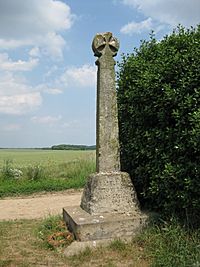
When Edward became king, people described him as handsome and full of energy. He was very tall for his time, about 6 feet 4 inches. He looked impressive in armor and wore splendid clothes. He did this to show how different he was from King Henry VI, who was physically weak and often ill.
On 2 February 1461, Edward won a difficult battle at Mortimer's Cross. Before the battle, people saw three suns in the sky. Edward used this as his symbol, called the "Sun in splendour". However, Warwick was defeated at the Second Battle of St Albans on 17 February. The Lancastrians got Henry VI back. Edward and Warwick met in London, where Edward was quickly crowned king.
Edward then marched north. The two sides met at the Battle of Towton on 29 March. It was fought in a snowstorm and was the bloodiest battle ever on English soil. It ended in a clear Yorkist victory. Many Lancastrian nobles died, which caused lasting anger among those who survived.
Margaret of Anjou fled to Scotland with her son, Edward of Westminster. The new king, Edward IV, returned to London for his coronation. Henry VI was caught later and imprisoned in the Tower of London.
Ruling from 1461 to 1470
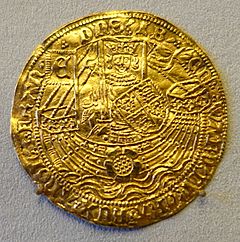
Most nobles had stayed loyal to Henry VI or remained neutral. This meant Edward had to rely a lot on the Neville family. At first, Edward focused on making his rule strong. John Neville's victory in 1464 seemed to end the Lancastrian threat. This then showed disagreements within Edward's own government, especially about foreign policy.
England, France, and Burgundy often tried to form alliances against each other. Edward preferred Burgundy as a partner. However, he let Warwick try to make a treaty with Louis XI of France. This treaty included a possible marriage for Edward with a French princess.
In October 1464, Warwick was very surprised to learn that Edward had secretly married Elizabeth Woodville on 1 May. Elizabeth was a widow with two sons. Her Lancastrian husband had died at Towton. This marriage showed Warwick that he was not fully in control of the king.
Edward's reasons for the marriage have been discussed a lot. Elizabeth's mother was from a noble family, but her father was a knight. The King's Council told Edward that she was "no wife for a prince such as himself."
The marriage was unusual. Historians think it was an impulsive decision by Edward. Some believe that Edward chose Elizabeth because her family, the Woodvilles, were not as powerful as the Nevilles. This meant they would rely more on Edward and be more loyal. However, everyone agrees that this marriage had a big impact on the rest of Edward's reign.
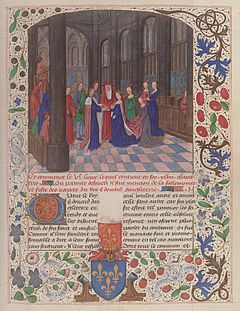
Elizabeth had twelve brothers and sisters who grew up. This created many new competitors for important jobs and lands. People became unhappy when Elizabeth's sisters made good marriages to powerful families.
In 1467, Edward removed Warwick's brother, George Neville, from his important job as Lord Chancellor. Warwick then made an alliance with Edward's unhappy younger brother, the Duke of Clarence. Clarence's lands were next to the Neville family's lands in the north. Edward stopped a planned marriage between Clarence and Warwick's daughter. In July, Clarence went against his brother and married Warwick's daughter.
Warwick, Clarence, and George Neville then returned to England. They gathered an army to remove Edward's "evil councillors" and improve the government. Edward was in the north, and his army was defeated in July 1469. Edward was held at Middleham Castle. His father-in-law and brother-in-law were executed.
However, Warwick and Clarence did not have much support. Edward was released in September and became king again. Things looked normal, but tensions remained. Edward did not do much to make the Nevilles feel safer. The Percy family, who were rivals of the Nevilles, had fought for the Lancastrians. Edward gave their lands back to them. This was a demotion for Warwick's brother, John Neville, who had been given those lands.
In March 1470, Warwick and Clarence started another rebellion. When it failed, they fled to France in May 1470. The French king, Louis XI, convinced Warwick to talk to his old enemy, Margaret of Anjou. She finally agreed to work with Warwick. With French help, Warwick landed in England in September 1470. He announced he would put Henry VI back on the throne.
By this time, many people were unhappy with Edward's rule. The Lancastrians quickly gathered a large army. When John Neville switched sides, Edward barely escaped capture. He was forced to flee to Bruges.
Edward's Exile and Return
Edward found safety in Flanders, which was part of Burgundy. He was with a few hundred men, including his younger brother Richard. Flanders was ruled by Charles the Bold, who was married to Edward's sister Margaret. Charles gave Edward very little help, which Edward never forgot.
The Lancastrian government that took over faced the same problems as before. Henry VI was too weak to rule, leading to struggles for power. The group that put him back on the throne included people who used to be bitter enemies. Warwick and Clarence quickly found themselves alone in the new government.
With money from rich merchants in Flanders, Edward landed near Hull in March 1471. At first, his supporters were slow to join him. The important city of York only opened its gates when Edward said he was just trying to get his dukedom back. The first large group to join him was 600 men. This made Clarence decide to switch sides and join Edward. As they marched south, more people joined, including 3,000 at Leicester.
Edward entered London without a fight and captured Henry VI. Warwick was defeated and killed at the Battle of Barnet on 14 April. A second Lancastrian army was destroyed at the Battle of Tewkesbury on 4 May. Edward of Westminster, the heir to the throne, died on the battlefield. Other Lancastrian leaders were executed soon after. Henry VI died a few days later. It is believed he was killed on Edward's orders.
Even though the Lancastrian cause seemed over, Edward's rule was still troubled by a fight between Clarence and his brother Richard. Both were married to the daughters of the Earl and Countess of Warwick. They were fighting over their wives' large inheritance.
Edward's Later Reign (1471-1483)
The last major rebellion against Edward ended in February 1474. Clarence was suspected of being involved in this rebellion. This was a reason for his execution in the Tower of London on 18 February 1478.
In 1475, Edward made an alliance with Burgundy and declared war on France. However, the Duke of Burgundy was busy with a siege. So, the French king, Louis XI, started talks with Edward. Soon after Edward landed in France, they signed the Treaty of Picquigny. Edward received a large payment and a yearly pension. This helped him get back the money he spent on his army.
In 1482, Edward supported an attempt to take the Scottish throne. Edward's brother, Richard, invaded Scotland and captured Edinburgh. However, they could not take Edinburgh Castle. The English army had to leave without much to show for the expensive campaign, except for capturing Berwick Castle.
Edward's health began to get worse. His doctors thought it was partly because he used to make himself sick after big meals so he could eat more. He became very ill in April 1483. He lived long enough to add instructions to his will. The most important one named his brother Richard as the Protector for his young son after his death. Edward died on 9 April 1483 and was buried in St George's Chapel, Windsor Castle. His twelve-year-old son, Edward V, was never crowned. Richard, Edward's brother, became King Richard III in July.
The exact cause of Edward's death is not known. In those times, people often thought poison was the cause when there was no clear explanation. Other ideas include pneumonia or malaria. One person at the time said it was due to a stroke caused by overeating, which fits with his habits.
Historians have studied Edward IV. Some earlier historians did not think he was a very important king. More recent historians, like Charles Ross, say that the peace and stability of his later reign were wasted. Ross also suggests that Edward "remains the only king in English history since 1066 in active possession of his throne who failed to secure the safe succession of his son." This means Edward's lack of planning may have led to the problems after his early death.
Edward's Government and Culture
How Edward Managed England
People noticed a big difference between Edward's first time as king and his second. After 1471, he became more determined, especially after attempts to make peace with old enemies failed. This included the execution of his brother Clarence. When he was young, Edward was a strong and charming military leader. But as he got older, he seemed to have less energy.
Because of this, Parliament became less willing to approve taxes for wars that Edward did not fully fight. He often used the money for his own household expenses instead. Under his rule, the Duchy of Lancaster became part of the Crown, where it still is today. In 1478, his staff created the 'Black Book', which was a detailed review of government money. This book was still used a hundred years later. Edward also invested a lot in businesses with the City of London, which gave him extra money.
Even though the economy got better after a difficult period, Edward often spent more money than he had. When he died in 1483, the Crown had very little cash. His close connection with the London branch of the Medici Bank ended with the bank going bankrupt. In 1517, the Medicis were still trying to get Edward's debts paid back.
Money matters were connected to foreign policy. Edward's reign was shaped by the relationships between England, France, and Burgundy. Two of these countries would often try to team up against the third. Since merchants from Flanders (part of Burgundy) bought a lot of English wool, Edward generally supported Burgundy. However, the Duke of Burgundy's unwillingness to help him in 1471 affected their relationship. When the Duke of Burgundy died in 1477, it led to a treaty in 1482. Flanders became part of the Holy Roman Empire, and France gained other lands. This meant Edward and future English kings lost some of their power in Europe.
Edward's Court and Books
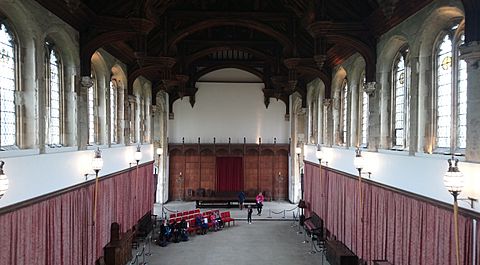
Edward's royal court was described as "the most splendid ... in all Christendom" by a visitor from Europe. He spent a lot of money on expensive items to show his power and wealth as king. He also enjoyed collecting beautiful books and showed interest in learning, especially history. He bought fine clothes, jewels, and furniture. He also had a collection of beautifully decorated historical and literary books, many made specially for him in Bruges.
These books included stories for fun and books for learning. They showed his interests, focusing on the lives of great rulers like Julius Caesar, historical stories, and religious works. In 1476, William Caxton set up the first English printing press. In 1477, he printed Sayengis of the Philosophres, which was translated into English for Edward by Anthony Woodville.
We don't know exactly where Edward's library was kept. But records show he moved books to Eltham Palace and had someone to look after "the king's bookes." More than forty of his books still exist from the 15th century. This suggests they were stored carefully. They are now part of the Royal Collection of manuscripts at the British Library.
Edward spent large amounts of money on Eltham Palace. This included the Great Hall, which still stands today. A big feast for 2,000 people was held there in December 1482, shortly before Edward's death. He also started a major renovation of St George's Chapel, Windsor, where he was buried in 1483. This chapel was later finished by Henry VII.
Edward's Family
Edward had ten children with Elizabeth Woodville. Seven of them lived longer than him. They were later declared not legitimate by a law in 1484, but this law was cancelled by Henry VII. Henry VII married Edward's oldest daughter, Elizabeth.
- Elizabeth of York (1466–1503): She became Queen of England and married Henry VII of England. She was the mother of King Henry VIII.
- Mary of York (1467–1482).
- Cecily of York (1469–1507): She married John Welles, 1st Viscount Welles.
- Edward V of England (1470–around 1483): He was one of the Princes in the Tower. He disappeared and is believed to have been murdered before his coronation.
- Margaret of York (1472).
- Richard, Duke of York (1473–around 1483): He was also one of the Princes in the Tower. He disappeared and is believed to have been murdered.
- Anne of York (1475–1511): She married Thomas Howard.
- George, Duke of Bedford (1477–1479).
- Catherine of York (1479–1527): She married William Courtenay, 1st Earl of Devon.
- Bridget of York (1480–1507): She became a nun.
Edward also had several children outside of his marriage.
- Elizabeth Plantagenet (born around 1464).
- Arthur Plantagenet, 1st Viscount Lisle (1460s/1470s–1542): He wrote important historical papers.
- Grace Plantagenet: She attended Elizabeth Woodville's funeral in 1492.
What Happened After Edward's Death
Edward IV's oldest son, also named Edward, was made Prince of Wales when he was seven months old. He was given his own household at age three, overseen by his uncle, Anthony Woodville. Most historians agree that Edward V and his brother Richard were killed, probably between July and September 1483. There is still debate about who ordered their deaths, but their uncle, Richard III, benefited from it.
By mid-August, Elizabeth Woodville was sure her sons were dead. She then began secret talks with Margaret Beaufort. Elizabeth promised her support if Margaret's son, Henry Tudor, agreed to marry her oldest daughter, Elizabeth of York. In December 1483, Henry promised to do so. He kept his promise after he was crowned king in October 1485.
Before he became king, Richard III declared his nephews illegitimate. He claimed that Edward IV's marriage to Elizabeth Woodville was not valid. This was because Edward had supposedly agreed to marry another woman, Lady Eleanor Talbot, before Elizabeth. A bishop claimed he had performed this earlier marriage. Once Henry VII became king, he cancelled this declaration. He also arrested the bishop, because his marriage to Elizabeth of York made his claim to the throne stronger.
Even with Henry VII on the throne, the Yorkist cause continued into the 16th century. There were famous people who pretended to be Edward's sons, like Lambert Simnel and Perkin Warbeck. Yorkist challengers remained a concern for Henry VII and his son, Henry VIII.
Genealogical Table
| Edward IV's position in relation to the houses of York and Lancaster (selective chart) |
|---|
Images for kids
See also
 In Spanish: Eduardo IV de Inglaterra para niños
In Spanish: Eduardo IV de Inglaterra para niños


